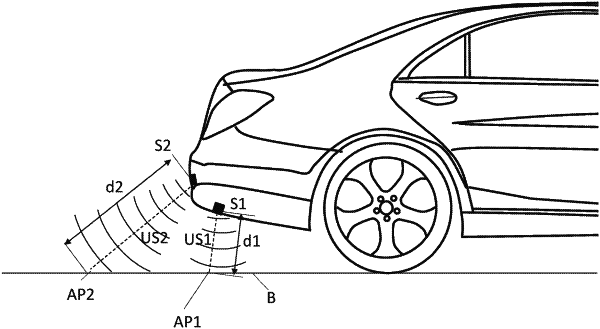| CPC B60W 40/02 (2013.01) [B60W 2420/00 (2013.01); B60W 2554/00 (2020.02)] | 12 Claims |

|
1. A method comprising:
emitting a first ultrasonic signal from a first sensor on a vehicle at a first angle relative to a surface on which the vehicle is operating;
emitting a second ultrasonic signal from a second sensor on the vehicle at a second angle relative to the surface on which the vehicle is operating, wherein the second angle is flatter relative to the surface than the first angle;
receiving a first reflection signal of the first ultrasonic signal by the first sensor;
receiving a second reflection signal of the second ultrasonic signal by the second sensor;
determining an expected difference between a first timing of the first reflection signal and a second timing of a second reflection signal based on a flat surface;
comparing a difference between the first timing of the first reflection signal with the second timing of the second reflection signal with the expected difference between the first timing of the first reflection signal and the second timing of the second reflection signal based on a flat surface,
wherein:
the first reflection signal is received by the first sensor and based on the first ultrasonic signal from the first sensor,
the second reflection signal is received by the second sensor and based on the second ultrasonic signal from the second sensor, and
the expected difference between the first timing of the first reflection signal and the second timing of the second reflection signal based on the flat surface is non-zero, due to the difference in the first angle and the second angle;
determining at least one of a presence of an unevenness in the surface on which the vehicle is operating or a presence of a curvature in the surface on which the vehicle is operating based on the comparison; and
based on the determination, indicating surface conditions to a superordinate computer for navigating the vehicle and/or outputting an alarm in a case that a surface rise or a surface dip exceeds a respective rise or dip threshold,
wherein comparing the difference between the first timing of the first reflection signal with the second timing of the second reflection signal with the expected difference between the first timing of the first reflection signal and the second timing of the second reflection signal based on a flat surface and determining the at least one of the presence of the surface unevenness or the presence of the surface curvature comprises:
executing an amplitude-based cross-correlation between a first temporal segment of the first reflection signal from the first sensor and a second temporal segment of the second reflection signal from the second sensor, and
generating a cross-correlation signal from the amplitude-based cross-correlation.
|